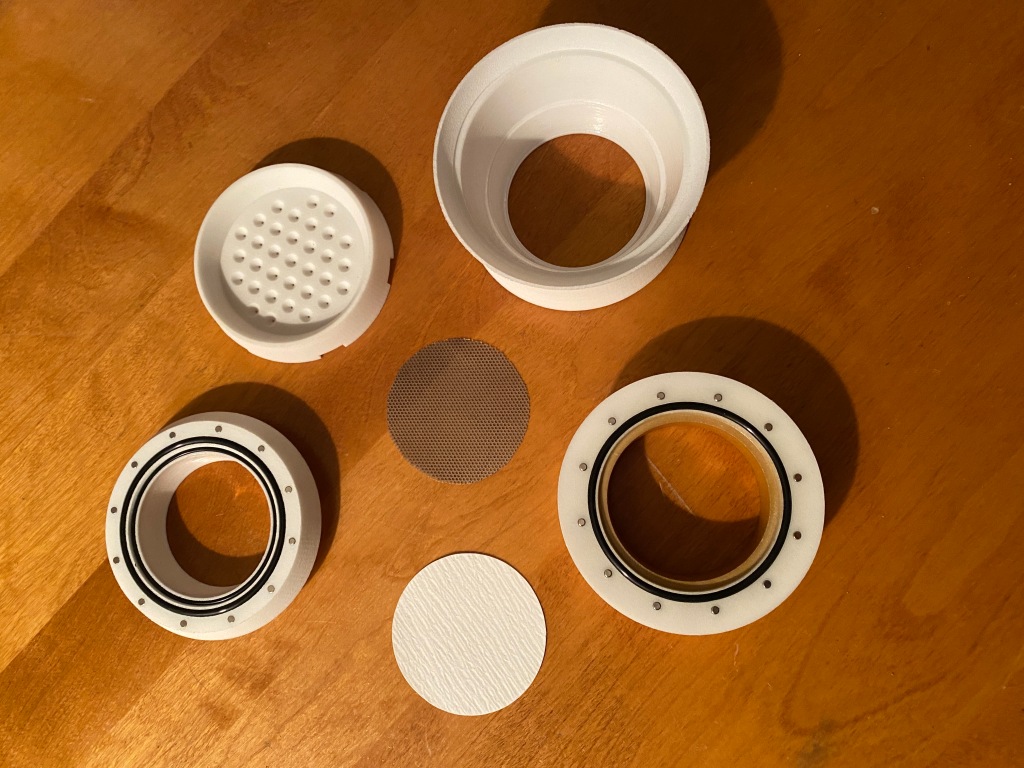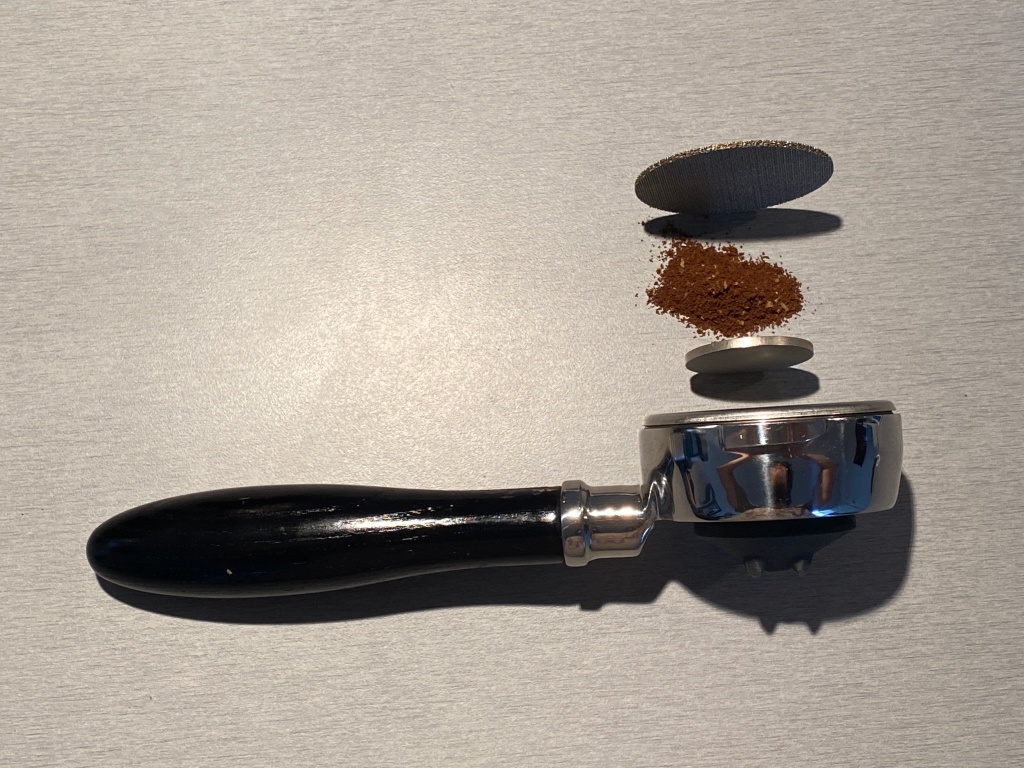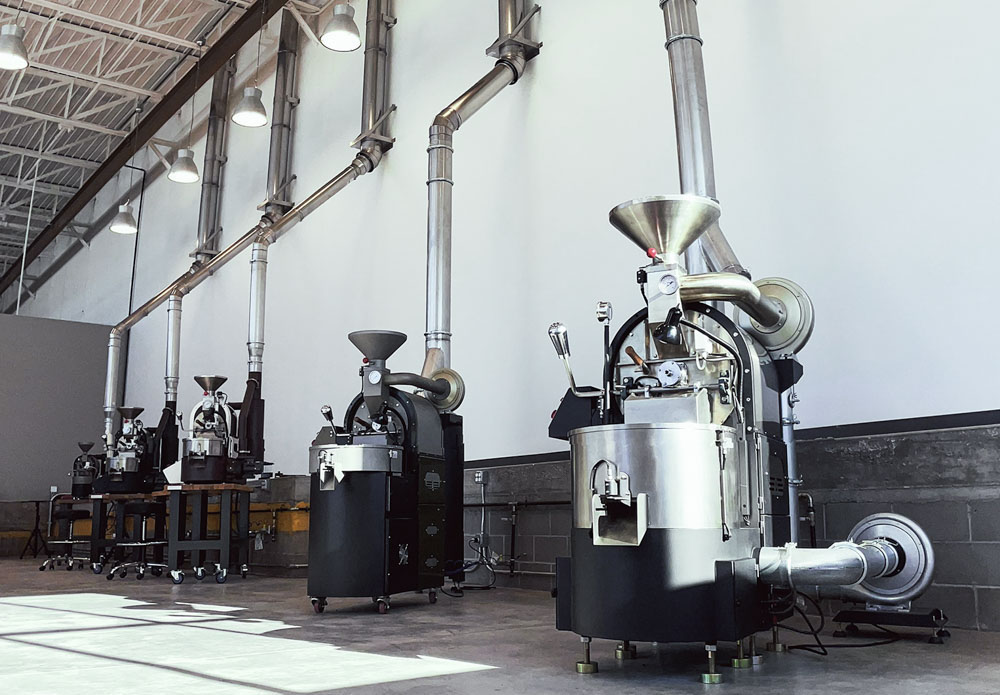
[Originally published on July 18 on my Patreon]
Header photo credit: @coffeeandlucas, @mymedia.studio
At this year’s Specialty Coffee Expo in Boston, I finally met Samo Smrke, a coffee scientist from whom I have learned a lot over the years, and who produces what are in my opinion some of the best scientific papers on the topic of coffee chemistry (e.g., on the topics of coffee degassing, coffee storage, and how roasting style affects the degassing). I told Samo about some of the weird observations I have made recently about astringency, which were on my mind because I could not figure out a model to explain them.
My first puzzling observation was that a long steep prepared in a Trinity One dripper could taste perfectly fine if I sampled it from the top after ten minutes, but astringent after it had gently flowed out from the bottom after opening the flow valve. This did not fit in my previous picture of what causes astringency, because I have always thought that an uneven flow of water through a coffee bed would cause astringency because it would over-extract the coffee particles along the channel where a lot of water had flowed. But here, the 10-minutes brew was very close to being saturated with coffee compounds, so I was expecting the dripping phase to be way less sensitive on the evenness of flow, but it was not ! What did I expect though ? This is coffee after all, and no easy shortcut ever works.
The second observation that was puzzling me happened during an experiment that Thibaut Paggen and I ran at the Canadian Roasting Society (CRS) one week-end. Thibaut has been busy developing a brand-new dripper called the SOL, which aims to achieve a perfectly even flow of water through the coffee bed, without bypass, and in a very modular way that will allow all kinds of different puck preparation tools to be applied to filter coffee. After playing with the dripper a bit, I was starting to be confident that the flow of water was getting very even through the coffee bed in his latest prototypes, and we met at CRS to compare different recipes that we had enjoyed at home with the prototype drippers. I tried something a bit classical, similar to what I would brew on Stagg X, with very nice results and an average extraction yield around 23% (the extraction yields quoted here are approximate to about ± 1%, as they rely on my spotty memory).

Thibaut was trying something a lot more radical, where he ground almost as fine as espresso, and still managed to achieve a nice drip rate above approximately 1 gram per second, which generated one of the brews I have tasted with the most intense and juicy flavors, at a staggering 26% average extraction yield. However, the brew was also unmistakably astringent. To my surprise, the astringency in that particular brew did not bother me as much as usual, and I still enjoyed the brew thanks to its incredible juiciness, but I would have definitely preferred it without the astringency. We also had the luck of being in the presence of Scott Rao, and he blessed us with his honest take on the two brews: he also found the second brew more astringent, and did not enjoy it as much as I did. This might not sound surprising to many of you, as grinding too fine has been known to generate astringency quite reliably. The part that surprised me, however, is that we could not get rid of the astringency even with a thick, high-quality paper filter, a thick bed of coffee that remained perfectly flat throughout, no bypass, and an apparently even flow of water in the absence of clogging. I thought this was pretty discouraging, as grinding very fine without astringency has been kind of a holy grail for me.

When I told this to Samo, he did not appear to be surprised at all, and he told me about colleagues that had recently likely discovered what chemical is responsible for astringency in coffee. Regular readers might remember one of my older blog postswhere I discussed the chemicals responsible for astringency in wine and raspberries; however, those specific chemicals were not found in large numbers in any coffee brews when scientists looked for them (see a nice discussion on that topic by Barista Hustle). While I don’t necessarily care about the name of the chemical that is responsible for astringency in coffee (I will keep it private until the scientific paper in question is published), I very much care about how it behaves, and why it may produce such odd experiences as the two I described above. And that was exactly what Samo was getting at: this compound, as others do, has a solubility curve that depends very strongly on the water temperature, in a way that is not at all linear.

If the solubility curves of different chemical compounds all had the same dependency on water temperature, changing the temperature while we brew would only have an impact on how fast we draw out coffee compounds during the brew (and thus on the average extraction yield). However, given that the solubility curves of coffee chemicals can have such different shapes, changing the temperature affects the relative quantities of chemicals, and therefore the flavor of the brew. The case of astringent compounds is particularly interesting, because they require a very high temperature to be dissolved efficiently in water. This is a really good thing for us, because if they were to dissolve in water, they would pass right through the coffee bed, as all the other tasty compounds do, and it would be almost impossible to avoid astringency.
This discussion really caused a light bulb to turn on in my mind, because this mechanism had the potential to explain all of my experiences with astringency. These astringent chemicals are mostly undissolved in the slurry, which means they can be filtered out if we achieve a gentle and even flow of water through a coffee bed that is thick enough. Readers of my book may be familiar with this power of filtration that a coffee bed has: it is actually much better at filtration than a paper filter itself, provided that it is thick enough and water flows evenly through it. Therefore, avoiding astringency is not directly a matter of flow evenness, it is actually a filtration problem ! In real-life scenarios, an uneven flow of water will just come with regions in the coffee bed that are not filtered well, whether this happens in a channel where the water can faster, or bypass water that flows around the edge of a coffee bed in a V60. This immediately explained my experience with the Trinity One; even though the slurry was saturated with coffee compounds, an uneven flow during drawdown would let more undissolved astringent compounds through, and into the cup.
This mechanism can also explain why grinding finer causes unavoidable astringency. If most of the astringent compounds are just “floating around” without getting dissolved efficiently, those that are trapped inside of an intact coffee particle won’t be able to come out into the slurry, which guarantees that they won’t end up in the beverage. The finer we grind, the more broken coffee cells we expose to the slurry, because the surfaces of large coffee particles, and the totality of very fine coffee particles will be made up of such broken cells. This also means that the finer we grind, the more astringent compounds we liberate in the slurry; the amount of such undissolved compounds we liberate is a direct proportion of the total surface area of coffee particles.

This immediately explains why we hit a wall of astringency when we grind, regardless of how evenly the water flows. As I mentioned before, the coffee bed is a more potent filter when water flows evenly through it, but it is by no means a perfect filter. Even if the coffee bed only allowed a small fraction of undissolved compounds to go through, that fraction might become noticeable in taste as we grind finer.
It is always lovely when a simple mechanism immediately explain a lot of puzzling observations, but the part that I love even more is that it can allow us to make predictions. The first one I would make based on these observations is the following: we may be able to push down to finer grind sizes if we achieve better filtration, either with a taller bed of coffee, a thoroughly tamped bed of coffee, or with a paper filter that is thick and has micron-sized pores (or even smaller). However, be careful not to require pressure during drawdown, because brewing with a higher pressure almost always correlates with a faster microscopic flow of water between the coffee particles, and this makes water more efficient at dragging any undissolved compounds to the cup (including fines, and probably astringent molecules too). I believe this is why espresso is always quite a bit astringent, although in this particular case it can fit in much better with the texture and flavor profile. This also explains why James Hoffman also found that pressing an Aeropress harder generated a more astringent cup (something I have also experienced, along with a more cloudy cup).
Here is another prediction that is more fun and a bit wild: I think that reducing the slurry temperature drastically may make it easier to avoid astringency, while still pushing average extraction yields to very high numbers. Imagine a scenario where only 1% of all the astringent compounds dissolve in water at 90°C, which may be a typical slurry temperature (I made up this 1% for the sake of this thought experiment). If you grind fine enough that this 1% becomes perceptible in the cup, one solution to reduce astringency is just to lower the slurry temperature, and make that fraction that can dissolve even smaller.
When I realized this, I told Thibaut, my Patreon followers and Scott Rao about it, and I asked them if they were willing to help me testing this out. My first experiment was to try brewing with the Ithaki, using Thibault’s method that involves a grind size almost as fine as espresso, distributed with the Weiss Distribution Technique and tamped, but using a brew temperature of 70°C. I experienced the same thing as my followers who tried it: this allowed me to achieve surprisingly high extraction yields (27%), with no astringency I could perceive. However, the cup profile was much less interesting, in the sense that the acidity was a lot less vibrant, and the taste profile veered more towards earthy, chocolaty, nutty and vegetal flavors. Scott’s answer to my text message was priceless: “Oh yes, I noticed this years ago but the cup profiles were always boring”. I guess another approach to discovering things in coffee is having tried everything possible, 20 years ago D: My Patreon followers tried several profiles on the Decent espresso machine with a drastically falling temperature profile and shared similar thoughts; the average extraction yields were surprisingly high, but the taste profile was not as vibrant.
While this odd experiment did not immediately need to a new and revolutionary filter coffee recipe, I think it is a nice demonstration that we are now on the right track in our interpretation of what causes astringency. All we need to figure out now is a way to achieve much better filtration. I believe this is also why Omri’s Del Creatives matrix filter allowed me to obtain such tasty coffee with a profile similar to Filter 2.0. After having used it many times, however, I was left with a problem where my pressure would always creep up, and the brews became gradually more astringent, cloudy and rancid, which I believe is due to the matrix filter slowly clogging up with coffee fines and oils. Using an ultrasonic bath did help, but it did not completely reset the filter. Samo had an interesting take on this: he said “yes you need an autoclave”. That seems a bit overkill for a home brewer set-up though, but I am definitely tempted (you could imagine having many metal filters, and cleaning them up in a big batch).

When Samo explained this to me in Boston, I asked him about tea, because this was something that had always troubled me: why is green tea so bad when it is brewed above approximately 70°C ? Well, the answer was simple ! There are other types of chemical compounds in green tea that taste quite harsh (bitter and astringent) which can dissolve at much lower temperatures. It is therefore much better to avoid dissolving them ! In the case of black tea, the processing that is involved might just be de-naturing the compounds in question, and removes the need for the low brew temperatures. This reminds me of decaffeinated coffee a lot; I have done many experiments with decaf that turned out not tasting astringent, and when I tried them with caffeinated coffee the results were much worse. This has led me to suspect that most decaffeinated beans are almost immune to astringency, probably because the processing in question might affect the chemical compounds responsible for astringency in coffee.
Coffee may therefore be a bit like green tea, except that the threshold temperature where the brew becomes automatically astringent and undrinkable may just be around something like 95°C instead of 70°C. In fact, I suspect this is the case based on some of my experiments with the Hario siphon. This brewer has the particularity of being able to keep a very high slurry temperature if needed, and I have never brewed anything that tasted good if I maintain a slurry temperature above 95°C consistently.
After reading this article, Samo Smrke had an interesting comment to make. He told me that he was not convinced that the undissolved astringent compounds in the cup participate to the actual sensation of astringency on the tongue, although more research was clearly needed about it. At first I thought that undissolved astringent compounds had to matter for the whole mechanism to match my observations described in the post above, but after thinking about it a bit more, I realized that perhaps not. In fact, the total quantity of astringent compounds in the cup of coffee will still be strongly affected by how well they were filtered by the coffee bed, and this may be enough to affect the fraction that actually dissolve in the cup in a way that changes our perception of astringency.
Scott Rao also made an interesting observation, and noted that with Filter 2.0 and other methods, a long contact time seems to matter for astringency, especially when the grind size is relatively fine. I suspect that this may fit within the mechanisms described above, because even if a small 1% of astringent compounds dissolve in water, exactly which molecule is dissolved or not will change from moment to moment. This means that an astringent compound within a coffee particle’s intact cell may dissolve, get out of the particle, and precipitate out again. This would likely be a very inefficient process at dragging out astringent compounds from a coffee particle (and oddly reminds me about Stephen Hawking’s mechanism to explain black hole dissipation), but it may help explain why long contact times, especially with clean water (otherwise some astringent compounds will also go back inside the coffee particles), may draw out more astringency.
TL;DR
- The molecules responsible for astringency in coffee are very hard to dissolve in water.
- Therefore, astringent compounds float around freely in the slurry, and avoiding astringency in the cup is a matter of filtration.
- One good way of filtering out the astringent compounds is with a thick, flat and undisturbed coffee bed, through which water flows relatively slowly and evenly.
- Grinding too fine will liberate a lot more astringent compounds by breaking more coffee cells, which will result in an astringent cup regardless of how even the water flows through the coffee bed. Even the thickest bed of coffee won’t be able to filter out all of the astringent compounds if you liberate too many of them.
- Extremely low slurry temperatures (think 70°C) can reduce the astringent compounds’ solubility even more, allowing to grind much finer and reach very high average extraction yields without astringency, but this also removes a lot of the interesting flavor compounds and makes the brews much less lively.
- I think we could unlock very interesting types of coffee brews if we were able to brew at regular temperatures, use a very fine grind, and rely on a secondary means to filter out everything that is undissolved from the brew.







